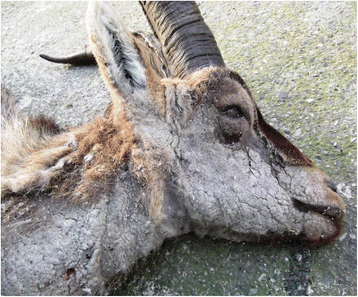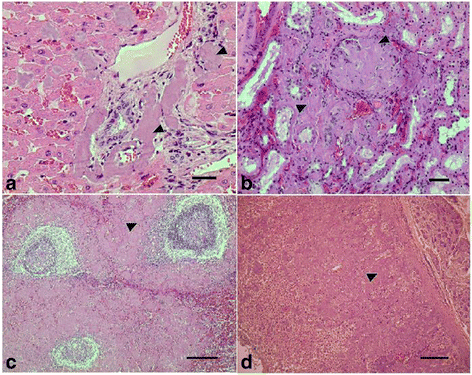Histopathology, microbiology and the inflammatory process associated with Sarcoptes scabiei infection in the Iberian ibex, Capra pyrenaica
- PMID: 29202802
- PMCID: PMC5715492
- DOI: 10.1186/s13071-017-2542-5
Histopathology, microbiology and the inflammatory process associated with Sarcoptes scabiei infection in the Iberian ibex, Capra pyrenaica
Abstract
Background: Sarcoptic mange has been identified as the most significant infectious disease affecting the Iberian ibex (Capra pyrenaica). Despite several studies on the effects of mange on ibex, the pathological and clinical picture derived from sarcoptic mange infestation is still poorly understood. To further knowledge of sarcoptic mange pathology, samples from ibex were evaluated from histological, microbiological and serological perspectives.
Methods: Samples of skin, non-dermal tissues and blood were collected from 54 ibex (25 experimentally infected, 15 naturally infected and 14 healthy). Skin biopsies were examined at different stages of the disease for quantitative cellular, structural and vascular changes. Sixteen different non-dermal tissues of each ibex were taken for histological study. Acetylcholinesterase and serum amyloid A protein levels were evaluated from blood samples from ibex with different lesional grade. Samples of mangy skin, suppurative lesions and internal organs were characterized microbiologically by culture. Bacterial colonies were identified by a desorption/ionization time-of-flight mass spectrometry system (MALDI TOF/TOF).
Results: The histological study of the skin lesions revealed serious acanthosis, hyperkeratosis, rete ridges, spongiotic oedema, serocellular and eosinophilic crusts, exocytosis foci, apoptotic cells and sebaceous gland hyperplasia. The cellular response in the dermis was consistent with type I and type IV hypersensitivity responses. The most prominent histological findings in non-dermal tissues were lymphoid hyperplasia, leukocytosis, congestion and the presence of amyloid deposits. The increase in serum concentrations of acetylcholinesterase and amyloid A protein correlated positively with the establishment of the inflammatory response in mangy skin and the presence of systemic amyloidosis. A wide variety of bacterial agents were isolated and the simultaneous presence of these in mangy skin, lymph nodes and internal organs such as lungs, liver, spleen and kidney was compatible with a septicaemic pattern of infection.
Conclusions: The alteration of biomarkers of inflammation and its implication in the pathogenesis of the disease and development of lesions in non-dermal tissues and septicaemic processes are serious conditioners for the survival of the mangy ibex. This severe clinical picture could be an important factor when considering the decision to eliminate animals that exceed a certain disease threshold from a population.
Keywords: Acetylcholinesterase; Bacteria; Lesion; Mangy skin; Non-dermal tissue; Sarcoptic mange; Serum amyloid a.
Conflict of interest statement
Ethics approval
This study complied with all Andalusian, Spanish and European legal requirements and guidelines regarding experimentation and animal welfare. Handling procedures and sampling frequency were designed to reduce stress and minimize the impact on the health of the subjects, as per European (2010/63/UE) and Spanish (R.D 53/2013) standards. The study was approved by the Ethics on Animal Welfare Committee of the University of Jaén and authorized by the Dirección General de Producción Agrícola y Ganadera of the Consejería de Agricultura, Pesca y Medio Ambiente of the Junta de Andalucía (Ref: SA/SIS/MD/ps/ October 25, 2012). The Sierra Nevada Natural Park staff also approved this study.
Consent for publication
Not applicable.
Competing interests
The authors declare that they have no competing interests.
Publisher’s Note
Springer Nature remains neutral with regard to jurisdictional claims in published maps and institutional affiliations.
Figures



Similar articles
-
Acute phase proteins increase with sarcoptic mange status and severity in Iberian ibex (Capra pyrenaica, Schinz 1838).Parasitol Res. 2015 Nov;114(11):4005-10. doi: 10.1007/s00436-015-4628-3. Epub 2015 Jul 31. Parasitol Res. 2015. PMID: 26227139
-
Evaluation of three enzyme-linked immunosorbent assays for sarcoptic mange diagnosis and assessment in the Iberian ibex, Capra pyrenaica.Parasit Vectors. 2016 Oct 21;9(1):558. doi: 10.1186/s13071-016-1843-4. Parasit Vectors. 2016. PMID: 27769278 Free PMC article.
-
Effects of sarcoptic mange on serum proteins and immunoglobulin G levels in chamois (Rupicapra pyrenaica) and Spanish ibex (Capra pyrenaica).Vet Parasitol. 2000 Mar 1;88(3-4):313-9. doi: 10.1016/s0304-4017(99)00221-6. Vet Parasitol. 2000. PMID: 10714470
-
Sarcoptic mange: An emerging panzootic in wildlife.Transbound Emerg Dis. 2022 May;69(3):927-942. doi: 10.1111/tbed.14082. Epub 2021 May 2. Transbound Emerg Dis. 2022. PMID: 33756055 Review.
-
Sarcoptic mange in wombats-A review and future research directions.Transbound Emerg Dis. 2018 Apr;65(2):399-407. doi: 10.1111/tbed.12770. Epub 2017 Nov 18. Transbound Emerg Dis. 2018. PMID: 29150905 Review.
Cited by
-
Epidemiological and Histopathological Investigation of Sarcoptic Mange in Camels in Egypt.Animals (Basel). 2020 Aug 24;10(9):1485. doi: 10.3390/ani10091485. Animals (Basel). 2020. PMID: 32846897 Free PMC article.
-
Survey of mange mite infesting sheep in Riyadh region, Saudi Arabia.Saudi J Biol Sci. 2022 Jan;29(1):595-600. doi: 10.1016/j.sjbs.2021.09.019. Epub 2021 Sep 16. Saudi J Biol Sci. 2022. PMID: 35002455 Free PMC article.
-
Sarcoptic Mange in Wild Caprinae of the Alps: Could Pathology Help in Filling the Gaps in Knowledge?Front Vet Sci. 2020 May 5;7:193. doi: 10.3389/fvets.2020.00193. eCollection 2020. Front Vet Sci. 2020. PMID: 32432130 Free PMC article. Review.
-
First Description of Sarcoptic Mange in a Free-Ranging European Wildcat (Felis silvestris silvestris) from Spain.Animals (Basel). 2021 Aug 25;11(9):2494. doi: 10.3390/ani11092494. Animals (Basel). 2021. PMID: 34573459 Free PMC article.
-
Silver and gold nanoparticles as a novel approach to fight Sarcoptic mange in rabbits.Sci Rep. 2024 May 9;14(1):10618. doi: 10.1038/s41598-024-60736-w. Sci Rep. 2024. PMID: 38724594 Free PMC article.
References
-
- Bornstein S, Morner T, Samuel WM. Sarcoptes scabiei and sarcoptic mange. In: Samuel WM, Pybus MJ, Kocan AA, editors. Parasitic diseases of wild mammals, 2nd ed. London, UK: Manson Publishing; 2001, pp. 107–119.
-
- Soulsbury CD, Iossa G, Baker PJ, Cole NC, Funk SM, Harris S. The impact of sarcoptic mange Sarcoptes scabiei on the British fox Vulpes vulpes population. Mammal Rev. 2007;37:278–296.
-
- Fandos P. La cabra montés (Capra pyrenaica) en el Parque Natural de las Sierras de Cazorla, Segura y Las Villas. Madrid: ICONA-CSIC; 1991. p. 176.
MeSH terms
Substances
LinkOut - more resources
Full Text Sources
Other Literature Sources
Medical

